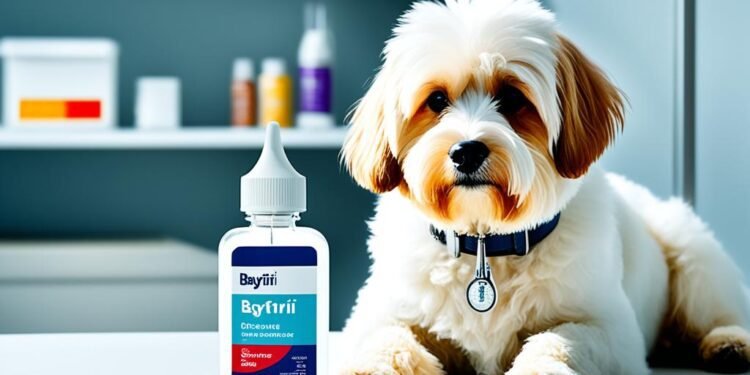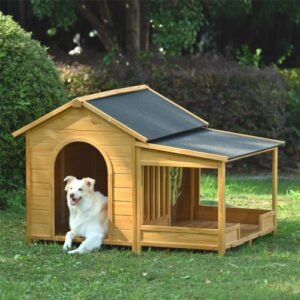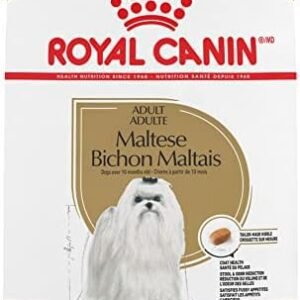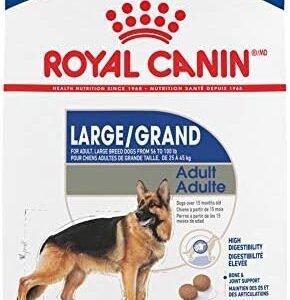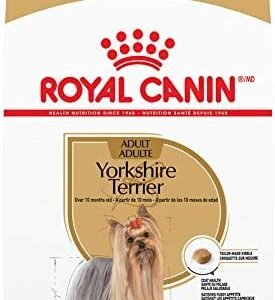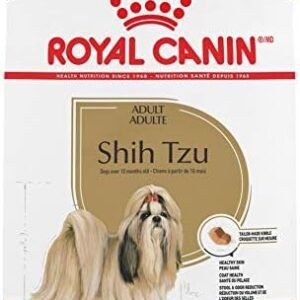Did you know that 80% of the Baytril dose goes straight into a dog’s bloodstream? This shows how strong and effective this antibiotic is. It’s key for pet owners to know how to use Baytril right to help their pets.
Key Takeaways
- Baytril (enrofloxacin) is a strong antibiotic for dogs and cats. It fights bacterial infections.
- It comes in tablets, liquid, and shots. Vets often use it for skin, breathing, and bladder infections.
- Dogs need 5-20 mg/kg, once or twice a day. Treatment can last from 2 to 30 days.
- Use Baytril carefully in young dogs and pets with health issues.
- Side effects include vomiting, diarrhea, and not eating. Rarely, dogs may feel tired, sad, have seizures, or harm their joint cartilage.
Table of Contents
What is Baytril?
Generic Name and Drug Type
Baytril is the brand name for the antibiotic enrofloxacin. It’s a synthetic drug that belongs to the fluoroquinolone carboxylic acid derivatives class. This antibiotic works against many types of bacteria, both Gram-negative and Gram-positive.
Enrofloxacin, known as Baytril®, is a fluoroquinolone antibiotic for treating bacterial infections. It’s used in dogs, cats, and other animals, even birds and reptiles, but not as officially approved. The drug starts working fast, within 1 to 2 hours, but its effects may take days to show.
Side effects of enrofloxacin include stomach problems like vomiting and diarrhea. Rarely, pets may have trouble walking, seizures, feel sad, or have allergic reactions. Don’t give it to pets that are allergic or if they’re not hydrated.
Be careful with enrofloxacin in pregnant pets, those with kidney or liver issues, or seizure disorders. Also, be aware of interactions with other drugs like antacids, other antibiotics, steroids, and theophylline.
Mechanism of Action
Baytril, known as enrofloxacin, stops bacterial DNA synthesis. As a fluoroquinolone antibiotic, enrofloxacin works by blocking the enzyme DNA gyrase. This enzyme is crucial for bacterial replication and survival.
This blockage stops the bacteria from replicating and dividing. It effectively kills the bacteria.
The way Baytril works can be explained as follows:
- Enrofloxacin, the key ingredient in Baytril, is a DNA gyrase inhibitor.
- It connects to and stops the bacterial enzyme DNA gyrase, which supercoils DNA during replication.
- This block prevents the proper unwinding and replication of bacterial DNA. It disrupts cell division and leads to cell death.
- The stoppage of DNA synthesis is the main way Baytril kills bacteria.
Baytril acts fast, usually in 1-2 hours, making it a great treatment for bacterial infections in dogs and cats. It works against both Gram-positive and Gram-negative bacteria. This makes it a versatile tool in veterinary care.
Understanding how Baytril works helps vets and pet owners. They can see how it fights bacterial infections in pets. This knowledge helps in managing various health issues.
Indications and Usage
Baytril Antibacterial Tablets are used to treat bacterial infections in dogs and cats. They work well for skin infections, respiratory infections, and urinary infections in dogs. For cats, they are effective against skin infections.
Baytril is known to fight off many harmful bacteria. These include Escherichia coli, Klebsiella pneumoniae, Proteus mirabilis, Staphylococcus species, and Pasteurella multocida.
Clinical Efficacy in Dogs and Cats
Baytril is used for bacterial infections in dogs and cats. It helps with infections in the digestive, respiratory, and urinary systems, skin, and ear infections. The product has been proven to work well in both dogs and cats.
- Baytril is not recommended for dogs under 1 year or large breeds under 18 months to protect their growing joints.
- Cats under 8 weeks should not take Baytril because it could harm them.
- Side effects from Baytril are rare. Gastrointestinal issues are most common, followed by neurological problems and allergic reactions.
The main ingredient, enrofloxacin, is partially removed by the kidneys. This is something to consider for animals with kidney problems. But, pregnant and nursing animals can safely use Baytril.
Baytril Dosage for Dogs

Recommended Dosage and Administration
Baytril (enrofloxacin) is a common antibiotic for dogs. It treats many bacterial infections. The right baytril dosage for dogs is 5-20 mg/kg (2.27-9.07 mg/lb) of body weight. You can give it once a day or split it into two doses every 12 hours.
Baytril comes in different strengths like 22.7 mg, 68 mg, and 136 mg chewable tablets. This makes it easy to adjust the dose for each dog. It’s best to give the medicine on an empty stomach. Food can affect how well it works.
The length of time you give baytril tablet dosage for dogs varies. It can be from 2-3 days after symptoms stop to up to 30 days for serious infections. Your vet will decide the best dose and how often based on your dog’s needs and how it reacts to the treatment.
| Baytril Tablet Size | Recommended Dosage Range |
|---|---|
| 22.7 mg | 1-4 tablets per day |
| 68 mg | 0.5-2 tablets per day |
| 136 mg | 0.25-1 tablet per day |
Always follow your vet’s instructions and finish the whole course of baytril 136 mg for dogs or other doses. This helps ensure the best results and prevents antibiotic resistance.
Pharmacokinetics and Distribution
Enrofloxacin, the key ingredient in Baytril, quickly gets absorbed from the gut and spreads through many body tissues and fluids in dogs and cats. After a 2.5 mg/kg oral dose in dogs, it reaches 50% of its peak level in 15 minutes and peaks in one hour. It takes about 2.5-3 hours to leave the body in dogs and more than 4 hours in cats. Most of it is passed out through urine, especially in this fluid.
Enrofloxacin is a last-choice treatment in fish farming and fights off bacterial infections from harmful germs like Aeromonas hydrophila and Flavobacterium columnare. In a study, 100 healthy Yellow River carp, each about 0.41 kg, got a 10 mg/kg oral dose of enrofloxacin. Researchers checked enrofloxacin and its breakdown product, ciprofloxacin, in the carp’s blood and tissues using HPLC.
| Parameter | Value |
|---|---|
| Area under the concentration-time curve (AUC) | Calculated using non-compartmental analysis |
| Peak concentration (Cmax) | Determined at various time points |
| Time to reach peak concentration (Tmax) | Measured |
| Elimination rate constant (λZ) | Calculated |
| Elimination half-life (T1/2λZ) | Calculated |
| Mean residence time (MRT) | Determined |
Studies looked into how enrofloxacin works in dogs and cats after giving them 5 mg/kg by vein or under the skin. Six dogs and six cats, half of each gender, were part of the study. Blood samples were taken for 24 hours to track enrofloxacin and its active form in the blood.
The study showed big differences in how dogs and cats handled the medicine, whether given by vein or under the skin. Dogs had a longer time for the medicine to work, more of it in their bodies, and higher levels of the medicine in their blood. Cats had less of the medicine available overall.
baytril for dogs
Baytril is a common antibiotic for dogs with many bacterial infections. It works against a wide range of bacteria that can cause skin, respiratory, and urinary tract infections. This makes it a broad-spectrum drug.
Baytril comes in different forms like tablets, liquids, and an ear solution. This variety lets vets choose the best treatment for each dog and its infection.
Treating Urinary Tract Infections in Dogs with Baytril
Baytril for dogs is often used for urinary tract infections (UTIs). Its strong action against bacteria makes it a top choice for treating UTIs in dogs. Vets may give Baytril tablets or liquids to treat and prevent UTIs from getting worse.
Baytril for Ear Infections in Dogs
Baytril is also used for ear infections in dogs. The Baytril Otic ear solution is FDA-approved for treating bacterial and fungal infections in dog ears. This targeted treatment helps clear the infection in the ear without the need for full-body antibiotics.
| Baytril Formulation | Approved Use |
|---|---|
| Oral Tablet | Dogs and Cats |
| Injectable | Dogs Only |
| Otic (Ear) Solution | Dogs Only |
While Baytril is a versatile antibiotic for dogs, it’s key to follow a vet’s advice on dosage and side effects. Using it responsibly is important for our dogs’ health.
Potential Side Effects
Baytril (enrofloxacin) is a common antibiotic for dogs, but it can cause side effects. Common baytril for dogs side effects include vomiting, diarrhea, and less appetite. Rarely, dogs may experience lethargy, depression, seizures, allergic reactions, dizziness, drowsiness, urine crystal formation, and high liver enzymes.
Baytril should be used carefully with young, growing dogs. It can harm their joint cartilage. This is especially true for large and giant breed puppies. They are more likely to have baytril side effects in dogs related to their bones and muscles.
| Common Side Effects | Rare Side Effects |
|---|---|
Vomiting Diarrhea Decreased appetite | Lethargy Depression Seizures Allergic reactions Dizziness Drowsiness Urine crystal formation Elevated liver enzymes |
Pet owners and vets need to know about these possible side effects. They should watch dogs closely while they take Baytril. If symptoms get worse, call the vet right away for help.
“Baytril should be used with caution in young, growing dogs, as it has the potential to cause damage to the joint cartilage.”
Knowing about Baytril’s side effects helps pet owners and vets use it safely. This way, they can make sure it works well for dogs.
Contraindications and Precautions
When using Baytril (enrofloxacin) in dogs, there are important things to keep in mind. Baytril is not safe for dogs or cats that are allergic to quinolone antibiotics, like enrofloxacin. This is the main ingredient in Baytril.
Also, Baytril is not safe for small and medium dogs when they are growing fast (2 to 8 months old). It’s also not safe for large and giant breed dogs when they are growing fast (up to one year and 18 months old, respectively). This is because it could harm the cartilage in young dogs.
Dogs and Hypersensitivity
Be careful with Baytril if your dog has had seizures or has kidney or liver problems. You might need to adjust the dose to avoid bad effects. Keep a close eye on these dogs when giving them Baytril.
Enrofloxacin, the key ingredient in Baytril, is not recommended during pregnancy. It could harm the developing cartilage in young animals. Think carefully about the risks and benefits before using it.
| Contraindication | Precaution |
|---|---|
| Dogs and cats with hypersensitivity to quinolone antibiotics | Dogs with a history of seizures |
| Small and medium breed dogs between 2-8 months of age | Dogs with kidney or liver disease |
| Large and giant breed dogs up to 1 year and 18 months of age, respectively | Pregnant animals |
Vets and pet owners need to know about these baytril contraindications in dogs. They should be careful when giving this medicine, especially to young dogs and those with health issues.
Drug Interactions
Baytril (enrofloxacin) is a common antibiotic for dogs with bacterial infections. It’s important for pet owners to tell their vet about all medicines their dog is taking before starting Baytril. This helps avoid harmful interactions.
Some medicines might not work well with Baytril. These include antacids, certain antibiotics, and NSAIDs. Also, dairy, iron, aluminum, and calcium products can affect Baytril’s effectiveness.
Other drugs to watch out for include cyclosporine, doxorubicin, phenytoin, theophylline, and warfarin. Always talk to your vet about any new medicines your dog is taking with Baytril.
| Medication Class | Potential Interaction with Baytril |
|---|---|
| Antacids | Can reduce the absorption of Baytril |
| Antibiotics | May have additive or antagonistic effects |
| Corticosteroids | Can increase the risk of tendon rupture |
| NSAIDs | May increase the risk of central nervous system side effects |
| Dairy, iron, aluminum, and calcium products | Can inactivate enrofloxacin |
Watch how your dog reacts to Baytril and tell your vet if there are any bad reactions. Talking and managing drug interactions can help keep your dog safe and healthy.
Storage and Handling
Storing and handling Baytril (enrofloxacin) right is key to its effectiveness and safety for your dog. Here’s what you need to know about keeping and using this antibiotic:
Storing Baytril Tablets
Keep Baytril tablets in a sealed container at room temperature, away from direct light. Make sure it’s out of children and pet reach to avoid accidental use.
Storing Baytril Liquid Formulations
Baytril liquids, like suspensions, should be kept cool, below 30°C (86°F), and not frozen. Once made, discard any liquid suspension by its expiration date.
| Baytril Formulation | Storage Requirements |
|---|---|
| Tablets | Store in a tight, light-resistant container at room temperature. |
| Liquid Suspensions | Store at temperatures below 30°C (86°F), protect from freezing, and discard after expiration date. |
Following the right storage and handling steps for Baytril is crucial. It keeps the medicine working well and keeps your dog safe. Always talk to your vet if you have questions about storing or using this antibiotic.
Conclusion
Baytril (enrofloxacin) is a powerful antibiotic for dogs. It treats many bacterial infections like skin, respiratory, and urinary tract infections. The study showed it worked well against canine bacterial pyoderma, with a 93.3% success rate.
But, the study found that treatment took longer than the recommended time. This shows the importance of following vet advice and watching the patient closely. It also warns us about the growing problem of antibiotic resistance in dogs and cattle.
Baytril is usually safe for dogs, but we must watch out for side effects. It’s especially important for young dogs and those with health issues. Vets need to think carefully before giving Baytril and keep a close eye on the dog during treatment for the best results.

















